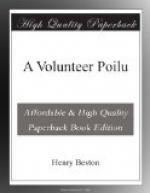Beyond the bridge, running almost directly north to Metz, lay the historic valley of the Moselle. Great, bare hills, varying between seven hundred and a thousand feet in height, and often carved by erosion into strange, high triangles and abrupt mesas, formed the valley wall. The ground color of the hills was a warm buff-brown with a good deal of iron-red in it, and the sky above was of a light, friendly blue. A strange, Egyptian emerald of new wheat, a certain deep cobalt of cloud shadows, and a ruddy brownness of field and moor are the colors of Lorraine. Here and there, on the meadows of the river and the steep flanks of the hills, were ancient, red-roofed villages. Across the autumnal fields the smoke and flame of squalid Pompey loomed strangely.
There were signs of the war at Marbache, fourteen kilometres from Nancy, slight signs, to be sure, but good ones—the presence of a military smithy for the repair of army wagons, several of which stood by on rusty wheels, and a view of some twenty or thirty artillery caissons parked under the trees. But it was at B------, sixteen kilometres from Nancy, and sixteen from the lines, that I first felt the imminence of the war. The morning train from Nancy had just stopped, to go no farther for fear of shells, and beyond the station the tracks of the once busy Nancy-Metz railroad advanced, rusty, unused, and overgrown with grass, into the danger zone. Far behind now lay civilian Pompey, and Marbache shared by soldiers and civilians. B------was distinctly a village of the soldiery. The little hamlet, now the junction where the wagon-trains supplying the soldiery meet the great artery of the railroad, was built on the banks of a canal above the river. The color of these villages in Lorraine is rather lovely, for the walls of the houses, built of the local buff-yellow stone and ferrous sand, are of a warm, brown tone that goes well with the roofs of claret-red tile and the brown landscape. A glorious sky of silvery white cloud masses, pierced with sunlight and islanded with soft blue, shone over the soldier village. There were no combatants in it when we passed through, only the old poilus who drove the wagons to the trenches and the army hostlers who looked after the animals. There were pictures of soldier grooms leading horses down a narrow, slimy street between brown, mud-spattered walls to a drinking-trough; of horses lined up along a house wall being briskly curry-combed by big, thick-set fellows in blousy white overalls and blue fatigue caps; and of doors of stables opening on the road showing a bedding of brown straw on the earthen floor. There was a certain stench, too, the smell of horse-fouled mud that mixed with that odor I later was able to classify as the smell of war. For the war has a smell that clings to everything miltary, fills the troop-trains, hospitals, and cantonments, and saturates one’s own clothing, a smell compounded of horse, chemicals, sweat, mud, dirt, and human beings. At the guarded exit of the village to the shell zone was a little military cemetery in which rows of wooden crosses stood with the regularity of pins in a paper.




